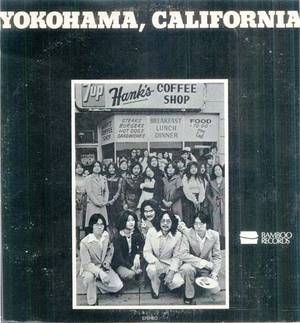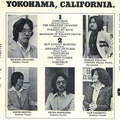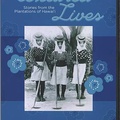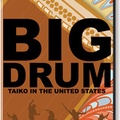Background and Issue Awareness:
YOKOHAMA, CALIFORNIA is the title of an LP record released by Asian American musicians in the San Francisco Bay Area and San Jose. Strongly influenced by A Grain of Sand (1973) by Chris Iijima, Nobuko Miyamoto, and Charlie Chin, the music was created in the midst of the Asian American movement. The front jacket photograph, taken in J-Town, San Jose, depicts the atmosphere of those days, with not only the band members but also P.J. Hirabayashi (San Jose Taiko) in the photo.
Originally, the trio of Peter Horikoshi, Sam Takimoto, and Michael Okagaki began working together, and were later joined by Robert Kikuchi-Yngojo and Keith Inouye to record the album. The album was released in 1977. The recording staff included Roy Hirabayashi. The record is an invaluable statement on artistic and cultural activities by Asian Americans in the 1970s, when their originality and presence was relatively unrecognized. Considering that even Asian Americans themselves did not show much interest in Asian American music (according to Steve Yamaguma, who worked on the album as the bassist, mixer and cover designer), the album is an extremely positive effort.
In genres other than literature, community activists who established their base outside university, such as Miyamoto, are seldom featured in documentary archives of Asian American studies (according to Prof. Masumi Izumi at Doshisha University, Kyoto, Japan). It is necessary to ignore the exclusion from Asian American studies of cultural and arts activities by Miyamoto, YOKOHAMA, CALIFORNIA and other persons, and to make a positive assessment of such activities. This presentation strives to reassess works and roles of Asian American musicians, and to identify their contemporary significance.
Origin of the Name:
As indicated in the beginning of the liner notes (upper right), respect is paid to Toshio Mori. Horikoshi visited Mori to request permission to use YOKOHAMA, CALIFORNIA as the name of his group. Mori agreed readily to the request. No direct relationship is found between the group’s lyrics and Mori’s writings.
Members:
All the members were either Japanese American or third-generation American with a Japanese ancestor. They used to enjoy playing music together with Philip Kan Gotanda (lower left poster) and David Henry Hwang. Based on the Asian American Musicians Organization (AAMO), several groups, including YOKOHAMA, CALIFORNIA, were formed. These groups played on university campuses, at Asian events and other opportunities, with some of them going all the way to Canada to play there.
Characteristics:
Many of YOKOHAMA, CALIFORNIA’s works are message songs with a strong presentation of identity awareness as an Asian American or Japanese American, although a pop sense is certainly demonstrated in the music. With simple lyrics, beautiful harmonies, and acoustic sound produced mainly by guitar, the songs feature themes such as that of a Japanese American temporary holding facility being lost in people’s memories with changing times, a declining town in which Filipino immigrants used to live, multiculturalism and the creation of identity, individuals’ relationships with Hiroshima/Nagasaki, mutual understanding and unity with others and other social and ethnic groups, and agony felt by people continuing the engagement in the Asian American movement. These themes were elements of a “Shared Mission” (according to Miya Masaoka). While their music was similar to that of folk songs of the same period in Japan, they were free from typical Asian and Japanese musical elements (such as pentatonic scale and the use of Asian and Japanese instruments). Meanwhile, another group named Hiroshima, composed of third-generation Japanese Americans, made a brilliant debut in Los Angeles around the same time. They used wadaiko (Japanese drum), koto (Japanese harp), and shakuhachi (Japanese vertical bamboo flute), incorporating Japanese music taste with jazz and fusion style. They signed an agreement with a major record company and achieved commercial success.
© 2012 Minoru Kanda






